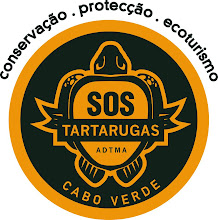We are delighted to announce that our research regarding the effect increasing amounts of beachfront development has had on nesting turtles since SOS Tartarugas started working in 2008 has been published in the magazine of the
Zoological Society of Cabo Verde.
 |
| Nesting beach July 2010 |
The research found that although hunting of female loggerhead turtles is still a major issue, habitat loss and light pollution are becoming a more serious threat. Construction sites, hotels, apartment buildings and restaurants close to beaches, bright lights and illegal removal of sand are contributing to a marked decrease in the total number of nesting turtles on some beaches. In 2009, beaches on Sal experienced an average increase in nests of 200%, while the beach most affected by construction (Tortuga Beach, which, ironically, is named after turtles) saw a decrease of nests of 7.3% (from 19.1% of total number of nests in 2008 to 11.8% in 2010). This beach also recorded a much lower nest to emergence ratio than normal - only 17.6% of turtles coming ashore here laid a nest compared to the more normal 29.9% seen in other areas. This indicates a reluctance to nest due to light pollution and other disturbances.
Nesting has halved on areas of Algodoeiro since 2008 while nesting on the beaches Santa Maria has declined from 7% of all nests to only 3% in 2010.
Even more alarming is the fact that 75% of nests had on Algodoeiro had to be moved in 2010 due to the threat of light pollution that would cause disorientation to the hatchlings at birth - this figure was much lower at 26% in 2008. On the east coast only 9% required relocation to the hatchery for this reason.

The results indicate a trend towards turtles moving from established nesting areas to beaches with less disturbance. However these other beaches have lower hatching success rates (such as Serra Negra which is subject to flooding) and higher mortality rates of nesting females as they are unpatrolled (northern beaches and in particular Mont Leão which accounts for 41% of all turtles killed on unpatrolled beaches).
Sadly, the beaches are bright but the future for turtles on Sal is not.
The full report can be read and downloaded here

 The results indicate a trend towards turtles moving from established nesting areas to beaches with less disturbance. However these other beaches have lower hatching success rates (such as Serra Negra which is subject to flooding) and higher mortality rates of nesting females as they are unpatrolled (northern beaches and in particular Mont Leão which accounts for 41% of all turtles killed on unpatrolled beaches).
The results indicate a trend towards turtles moving from established nesting areas to beaches with less disturbance. However these other beaches have lower hatching success rates (such as Serra Negra which is subject to flooding) and higher mortality rates of nesting females as they are unpatrolled (northern beaches and in particular Mont Leão which accounts for 41% of all turtles killed on unpatrolled beaches).




